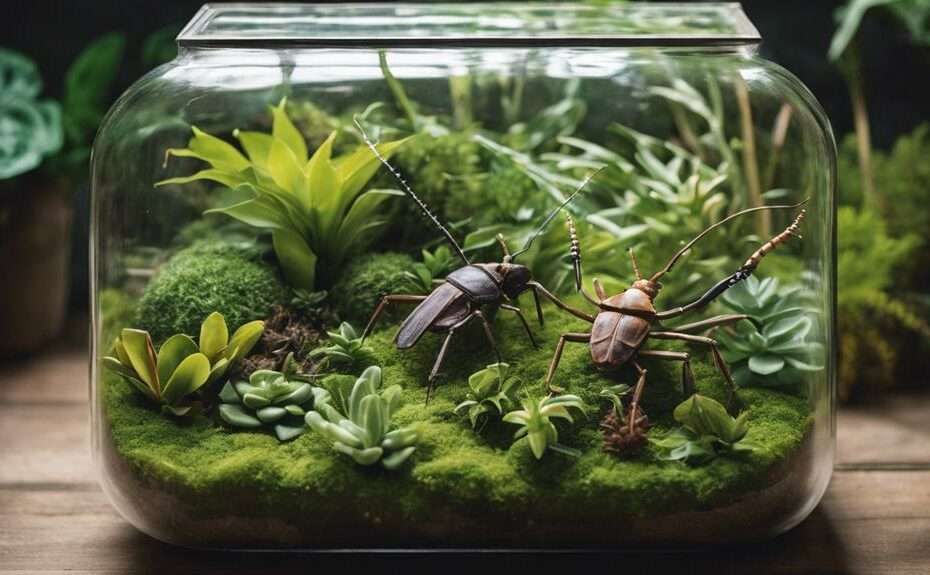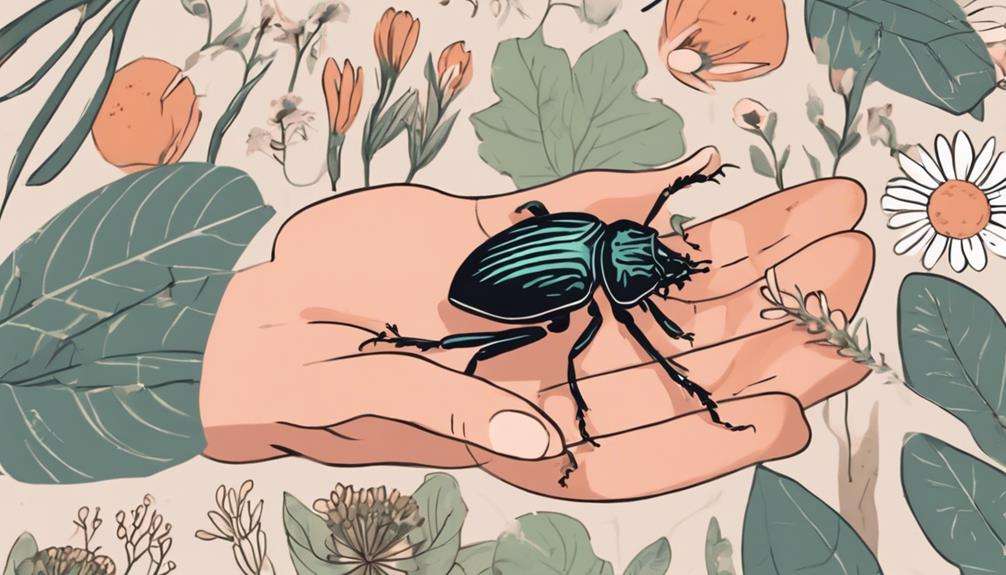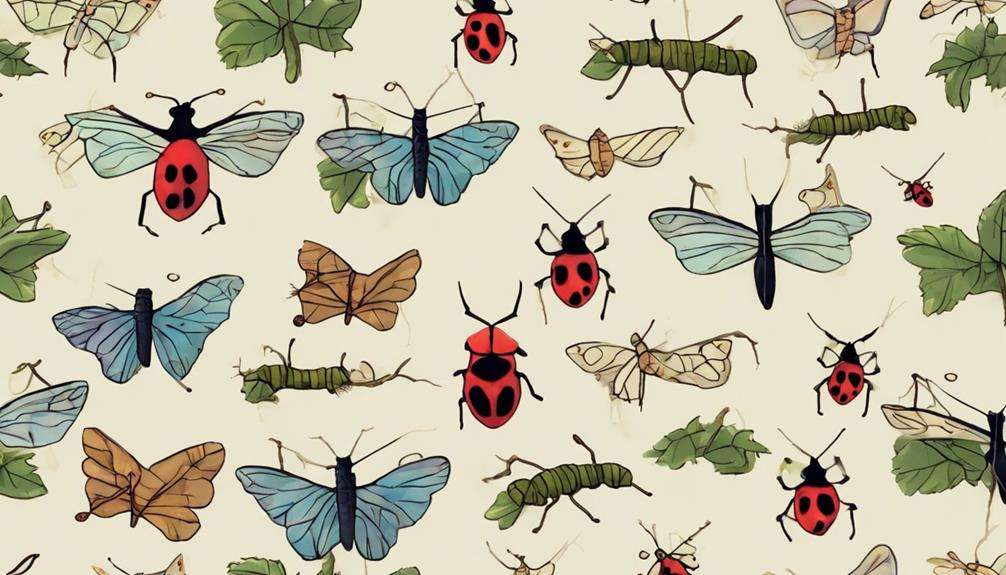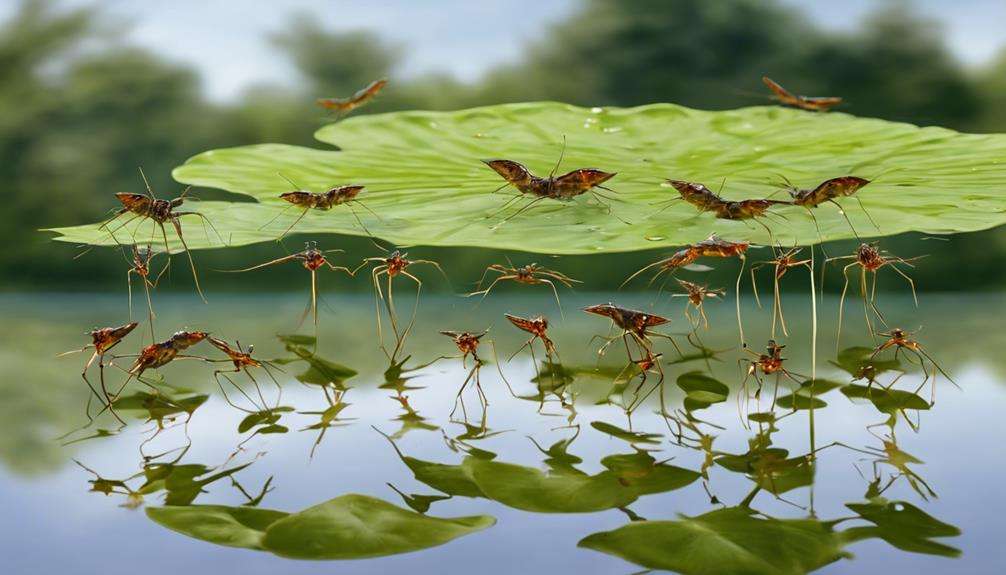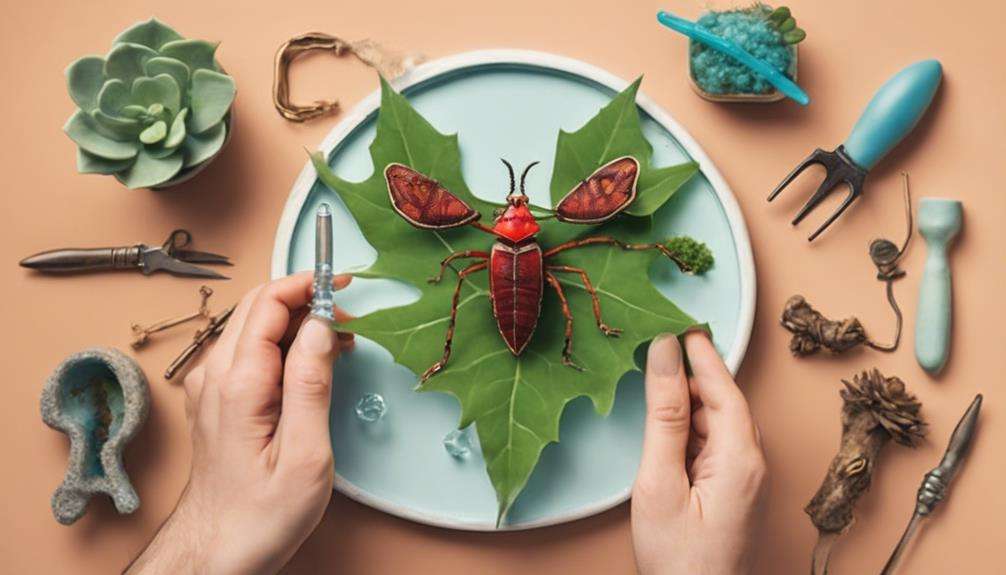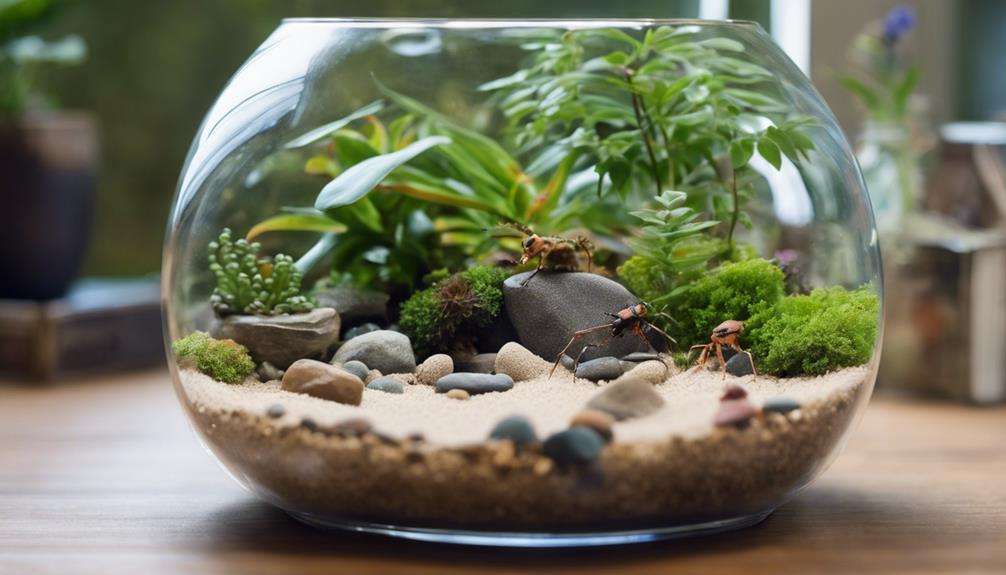Imagine stepping into a miniature forest within your home, where delicate leaves come to life in the form of your exotic leaf insects. The intricate world of maintaining these alluring creatures as indoor pets opens up a world of possibilities for those seeking a unique and enriching companion experience.
Carefully exploring the nuances of their care and environment can lead to a gratifying journey, but what secrets lie beyond the surface of their leafy disguise?
Key Takeaways
- Provide specific plant diets like bramble leaves or oak for optimal nutrition
- Maintain humidity levels for moulting and health
- Ensure a well-ventilated enclosure to prevent mold growth
- Handle leaf insects gently to prevent damage and stress
Leaf Insect Care Essentials
To properly care for leaf insects in captivity, it's important to provide them with specific plant diets and maintain ideal humidity levels in their enclosure. Leaf insects are easy to keep when their dietary needs are met. They thrive on bramble leaves, oak, or evergreen oak. Ensuring a well-ventilated enclosure is critical for their well-being. Proper ventilation helps prevent mold growth and maintains air quality.
Maintaining the right humidity levels is essential for leaf insects. They require a humid environment to support successful moulting processes and overall health. A well-ventilated enclosure also aids in regulating humidity levels, preventing excessive moisture buildup that could lead to bacterial or fungal growth.
Creating the Ideal Habitat
For prime care of leaf insects, the habitat must provide ample vertical space for molting and climbing, along with strategic ventilation to maintain air quality and prevent mold growth. Since leaf insects are tropical species, creating a humid environment is essential. To mimic their natural habitat, maintain humidity levels between 60-80%.
Use artificial plants or live branches within the enclosure to offer climbing opportunities and hiding spots for your leaf insects. These plants also help in creating a visually appealing habitat. Make sure the enclosure has proper ventilation to prevent the buildup of excess moisture that can lead to mold growth. Additionally, provide a substrate of moist sand or coconut fiber to help retain humidity levels.
Feeding Your Leaf Insects
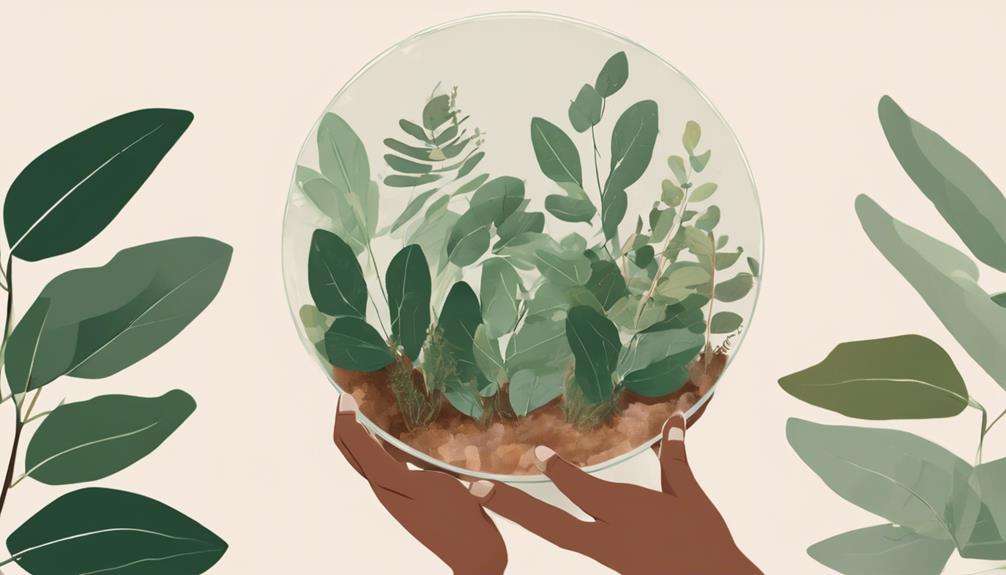
Leaf insects primarily consume bramble leaves, oak, or evergreen oak as their main diet. To confirm their health, avoid feeding them plants sprayed with pesticides. Provide fresh leaves washed and stored in a jar of water to maintain hydration and freshness. Cover the jar with fine netting to prevent accidental drowning while the leaf insects feed.
Young leaf insects may require gentle confirmation to feed; misting the leaves sparingly can aid in hydration and feeding. It's essential to monitor the freshness of the leaves regularly, removing any wilted or moldy ones promptly. By offering a constant supply of suitable fresh leaves and maintaining a clean feeding environment with the necessary precautions like fine netting, you can help keep your leaf insects healthy and content.
Handling and Interacting Safely
When handling exotic leaf insects, require gentle coaxing onto your hand to prevent leg shedding and minimize stress. It's important to approach them with care to avoid injuries during interaction.
To guarantee the well-being of these delicate creatures, follow proper handling techniques that involve minimizing direct contact and refraining from unnecessary handling. Frequent handling should be avoided unless necessary to reduce the risk of damage and stress to the leaf insects.
Remember that these exotic pets are sensitive and require gentle care to thrive in captivity. Minimize direct contact with them to prevent any harm or stress, as they're particularly fragile.
Breeding Leaf Insects Indoors
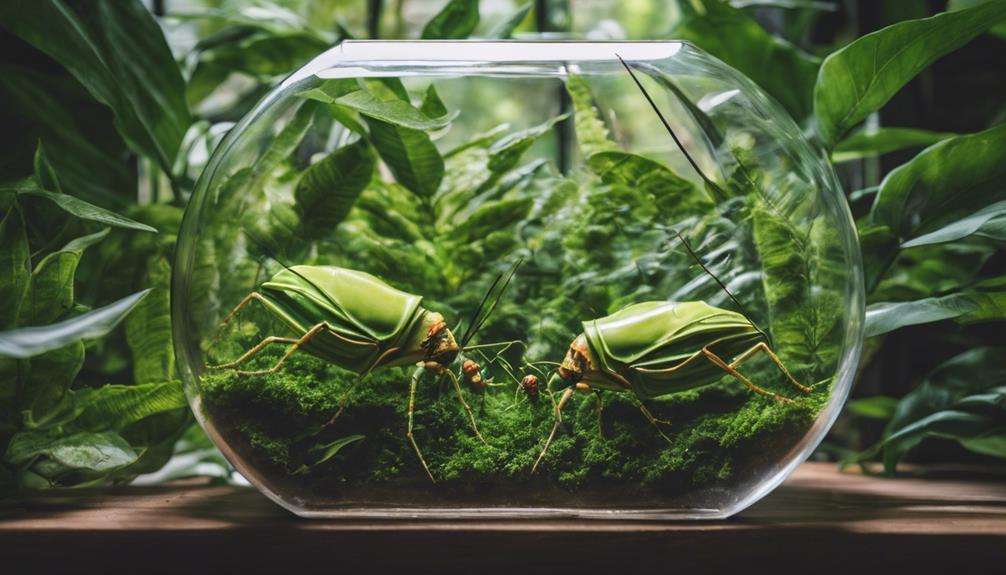
To initiate the breeding process of leaf insects indoors, focus on creating a controlled environment conducive to egg laying and hatching. Female leaf insects will lay approximately 40 eggs, usually at a rate of 1-2 eggs per day.
To make sure successful hatching, place the eggs on moist silver sand within a container that has a secure lid. Maintaining a consistent temperature of 20-25°C is vital for the eggs to hatch successfully.
Once the eggs hatch, provide young leaf insects with fresh bramble with cut edges as their primary food source. It's imperative to exercise careful rearing practices and provide close attention during the early stages of development to promote the well-being of the young leaf insects.
Dealing With Lost Limbs
In cases of limb loss in leaf insects, ensuring proper humidity levels during moulting is essential for the potential regrowth of limbs. Leaf insects have the remarkable ability to regrow lost limbs only during the moulting process, a critical stage in their development. It's important to understand that adult leaf insects lose this regenerative capacity, underscoring the significance of maintaining an environment conducive to moulting.
Dry environments pose a particular challenge for leaf insects during moulting, hindering their ability to regrow limbs effectively. Hence, monitoring the moulting process closely is paramount to prevent limb loss in these fascinating creatures. Successful moulting is paramount for the regrowth of lost limbs in leaf insects, emphasizing the necessity for meticulous care and attention to detail.
Health and Common Issues
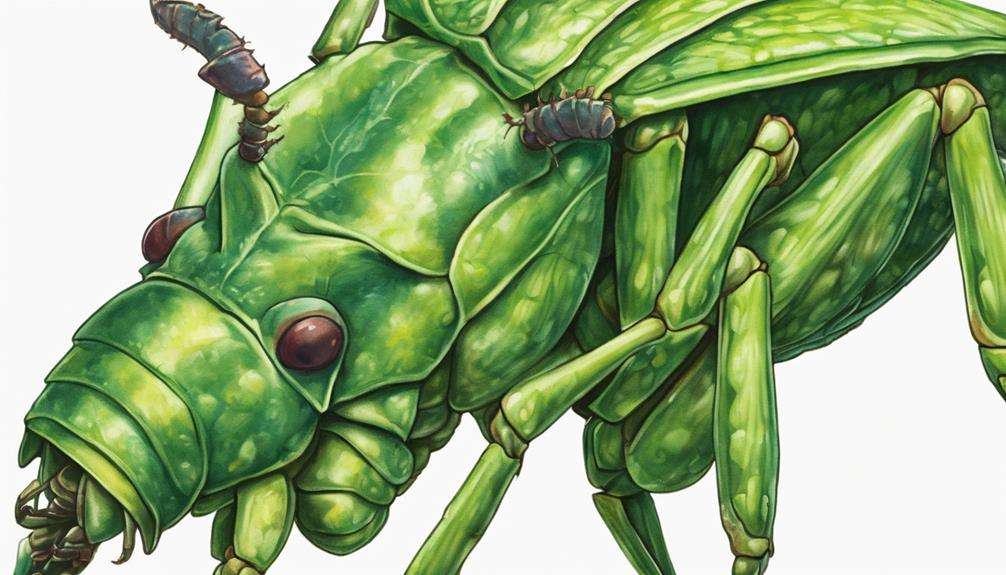
Monitor your leaf insects' diet closely to guarantee they receive proper nutrition.
Implement preventative health measures like maintaining ideal humidity levels and observing for signs of stress.
Familiarize yourself with common illnesses to promptly address any health issues that may arise.
Leaf Insect Diet
How do leaf insects maintain their health through their diet, and what're some common issues related to their nutrition?
Leaf insects rely on a diet primarily consisting of fresh leaves such as bramble, oak, or evergreen oak. Ensuring the leaves are important to prevent health issues. Fresh leaves should be washed and stored in a jar of water to retain their freshness for leaf insects. To prevent drowning during feeding, cover the jar with fine netting.
Young leaf insects may require encouragement to feed, so lightly misting the leaves for hydration can be beneficial. By providing a suitable diet and addressing potential nutritional issues promptly, you can help important the well-being of your leaf insects.
Preventative Health Measures
To safeguard the well-being of your indoor leaf insects, vigilantly maintaining best humidity levels is imperative to prevent dehydration and guarantee successful moulting. Stick insects, like leaf insects, shed their skin periodically as they grow. Insufficient humidity can lead to difficulties during the moulting process, resulting in health issues or even death.
Additionally, providing a diverse diet of fresh, pesticide-free leaves is essential for the overall health and vitality of your leaf insect pets. Monitoring their behavior for signs of stress, illness, or abnormal activity is vital in catching any health concerns early.
Ensuring a clean enclosure free of mold and bacteria will help reduce the risk of infections and respiratory problems. Remember, if you notice any worrying health issues, seek the expertise of a veterinary specialist in exotic animals promptly.
Identifying Common Illnesses
Common illnesses that can affect leaf insects include dehydration, fungal infections, and bacterial infections. Dehydration in leaf insects can present as lethargy and loss of appetite. To address dehydration, mist the enclosure regularly and provide a water source for drinking.
Fungal infections can manifest as discoloration or unusual behavior. Preventing fungal and bacterial infections involves maintaining proper hygiene by cleaning the enclosure frequently. If you notice symptoms of illness in your leaf insect, such as unusual behavior or discoloration, seek veterinary care from an exotic animal specialist promptly.
Monitoring your leaf insect's health closely and taking quick action when issues arise can help maintain their well-being and quality of life.
Further Resources for Leaf Insect Care
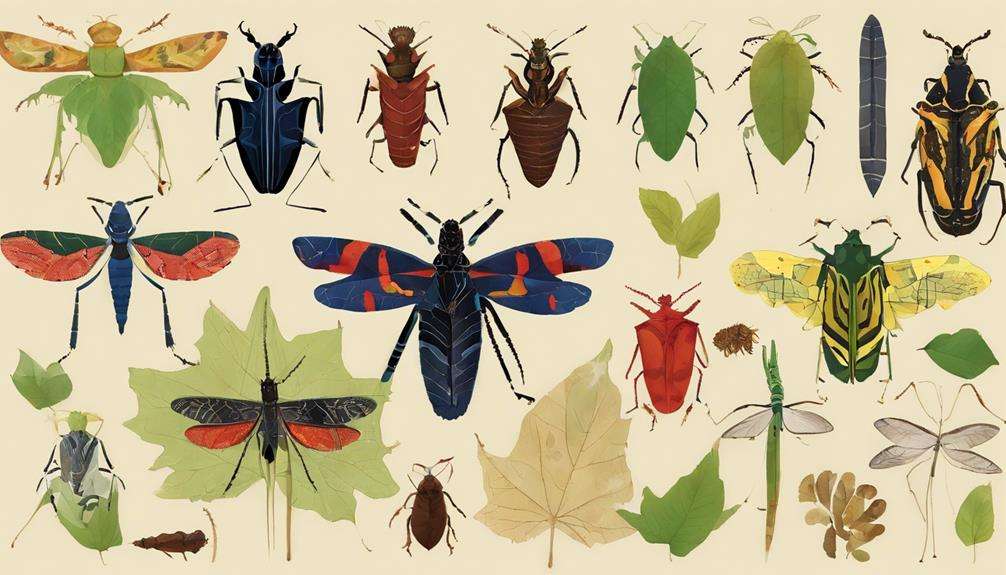
To guarantee the well-being of your leaf insects, it's essential to understand their care tips, habitat requirements, and dietary needs.
Providing the correct plant species for feeding and maintaining proper humidity levels are critical aspects of their care.
Utilizing available resources can offer detailed guidance on how to best care for, breed, and handle leaf insects as enchanting indoor pets.
Care Tips for Leaf Insects
When caring for leaf insects, ensuring a diet of fresh bramble leaves, oak, or evergreen oak that's pesticide-free is essential for their well-being. Leaf insects, similar to praying mantises and certain species of stick insects, are herbivores and require a specific plant-based diet to thrive.
It's vital to provide a continuous supply of these leaves, making certain they're free from any chemicals that could harm the delicate leaf insect. Additionally, proper handling techniques should be employed to prevent any injuries to these fragile creatures. Understanding their dietary needs and handling them gently are key aspects of effectively caring for leaf insects.
Habitat Requirements
Properly accommodating your stick and leaf insects' climbing behavior necessitates providing a tall cage of at least 30cm in height. Suitable housing options include fish tanks, garden propagators, plastic sweet jars, or custom netted cages for ventilation.
Be cautious with older sweet jars to avoid condensation buildup and drowning risks. Make sure to use fresh bramble leaves, oak, or evergreen oak for food, making certain they're pesticide-free.
Minimal handling of leaf insects is advised to prevent stress and injury, promoting their well-being. Remember, maintaining a vital habitat is important for the health and longevity of your stick and leaf insects, aiding in creating a comfortable and safe environment for them to thrive.
Dietary Needs
For best health and development of leaf insects, providing a diet primarily consisting of bramble leaves, oak leaves, or evergreen oak leaves is essential. Meeting their dietary needs with these specific leaves guarantees leaf insects receive the necessary nutrients for best growth.
Avoid feeding them plants sprayed with pesticides as this can harm their health. To maintain hydration and freshness, wash fresh leaves and store them in a jar of water.
For young leaf insects that may need encouragement to feed, mist the leaves sparingly to stimulate their appetite. Covering the jar of leaves with fine netting is critical to prevent drowning and ensure the safety of leaf insects while they're feeding.
Following these feeding requirements will contribute to the overall well-being of your leaf insects.
Frequently Asked Questions
Can You Keep a Leaf Bug as a Pet?
You can keep a leaf bug as a pet. Proper leaf bug care involves providing the right food plants like bramble leaves, oak, or evergreen oak. Handling with care is important to prevent stress and injury.
How Do You Keep a Pet Spiny Leaf Insect?
To keep a pet spiny leaf insect, guarantee a varied diet including eucalyptus, bramble, and rose leaves. Create a well-ventilated habitat with climbing branches. Minimize handling to prevent stress. Separate eggs for breeding success. Maintain humidity at 60-70% for healthy growth.
How Long Do Leaf Insects Live in Captivity?
Leaf insects can live up to a year or longer in captivity, depending on species and care. Factors like diet, humidity, and handling affect their lifespan. Providing a suitable environment and monitoring health are essential for their longevity.
Can You Hold Leaf Insects?
You can hold leaf insects with caution, following proper handling techniques to prevent harm. Minimize direct contact to avoid stress or injury. Behavioral observations can guide communication with these delicate creatures, ensuring their care requirements are met.
Conclusion
As you observe your leaf insects slowly crawling along the branches, blending seamlessly into their surroundings, you can appreciate the intricate beauty of these remarkable creatures. Their delicate bodies and graceful movements serve as a reminder of the wonders of nature that can be enjoyed right in your own home.
By following the proper care guidelines and providing a suitable environment, you can continue to marvel at the unique characteristics and behaviors of your exotic leaf insects.
